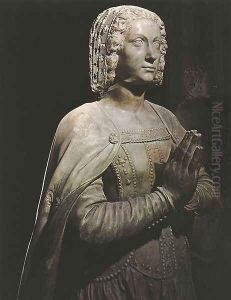Pierre Bontemps Paintings
Pierre Bontemps was a French sculptor renowned for his work during the Renaissance period. Born in approximately 1505, though the exact date and place of his birth remain unclear, Bontemps emerged as an influential artist in the mid-16th century. His career was marked by his skill in both sculpture and stonemasonry, and he became known for his elegant style and his ability to work with different materials, including marble, stone, and wood.
Bontemps is perhaps best known for his funerary art. He was responsible for the tomb of Francis I of France, which is considered one of his masterpieces. This work was commissioned by Henry II and is found in the Basilica of Saint-Denis, the burial place of French kings. The monument is a remarkable example of Renaissance art, showcasing the transition from Gothic to Renaissance styles and is noted for its detailed carvings and the lifelike effigies of the king and his queen.
Another significant work attributed to Bontemps is the recumbent statue of Charles de Maigny, a master of the wardrobe to Francis I, which displays Bontemps' talent in portraying human figures with a sense of dignity and tranquility. His works often reflected the humanist ideals of the Renaissance, focusing on the beauty and expressiveness of the human form.
Throughout his career, Pierre Bontemps worked on various projects, including decorative elements for royal residences and religious institutions. He was also involved in the restoration of antique statues, which was a testament to his deep understanding of classical forms and his ability to integrate these influences into his work.
Pierre Bontemps' contributions to French Renaissance art were significant, and his works remain a testament to his skill and artistry. He died in 1568, leaving behind a legacy that continues to be appreciated by art historians and enthusiasts. His works can still be seen today and are considered important artifacts of the cultural reawakening that characterized the Renaissance period.
